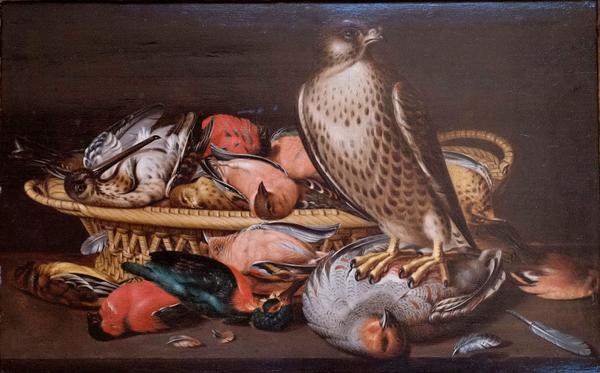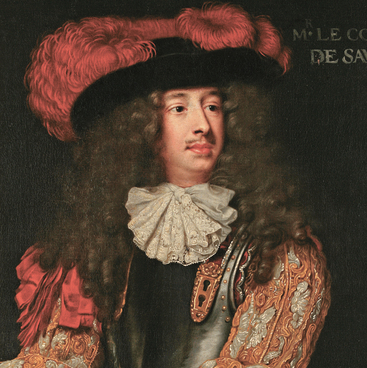Nikolas Cave is a Flemish painter and author of animalistic still life.
Almost nothing is known about his biography. Experts believe that the life of Cave was intertwined with Antwerpen – a cultural metropolis of the Southern Netherlands. His name was first mentioned in 1619 when he was registered as a member of the local guild of Saint Luke, a professional association of artists. The minimum requirements to join the guild were availability of own accommodation and urban citizenship.
It is unknown, who taught Nicolas Cave, however, in his slightly aloof picturesque painting the influence of early Flemish still life masters – Clara Peeters and Osias Beert – is obvious. On the other hand, the stylistic elements of his creativity demonstrate an expressed individuality.
The presented picture is one of the early samples of the Dutch ‘hunting’ still life. Its symbols are fueled by an ancient notion about a bird as an image of human soul. Probably, the dead birds embody lost souls of sinners.
This work is interpreted controversially. According to one version, the hunting falcon represents a triumph of virtue. It tramples on the quail that in the medieval folklore steadily impersonated lusty passion and heretical temptation.
According to another version, falcon is a lazy bird feeding with wastes. It is compared with a human being thinking about his womb. Apart from this, cowardice and assault on the vulnerable are attributed to falcon.
An image of the falcon and the heron resembling the present picture in terms of the composition can be found in the collection ‘Symbols and Emblems’ of Joachim Camerarius first published in 1590 in Nurnberg. The first symbolizes vice and the second – virtue. The picture is accompanied with a Latin motto ‘Exitus in dubio est’ – ‘outcome is doubtful’.
It is an interesting fact that the surname of the artist, whose painting contains both mentoring and warning, literally means a call to alertness: ‘Cave! ’ that means in Latin ‘Beware! ’
The signature of Nicolas Cave is in the left lower part of the painting, in the author picturesque layer. The research conducted under UV rays and under the microscope confirmed its authenticity. The graphics of the letter and crazing – cracks of the paint on the place of signature – also correspond to the time when the artist lived.
Currently, this canvas is a sole authentic piece of work by Nicolas Cave and may serve as a benchmark for future attributions of his other uncompleted works.
Almost nothing is known about his biography. Experts believe that the life of Cave was intertwined with Antwerpen – a cultural metropolis of the Southern Netherlands. His name was first mentioned in 1619 when he was registered as a member of the local guild of Saint Luke, a professional association of artists. The minimum requirements to join the guild were availability of own accommodation and urban citizenship.
It is unknown, who taught Nicolas Cave, however, in his slightly aloof picturesque painting the influence of early Flemish still life masters – Clara Peeters and Osias Beert – is obvious. On the other hand, the stylistic elements of his creativity demonstrate an expressed individuality.
The presented picture is one of the early samples of the Dutch ‘hunting’ still life. Its symbols are fueled by an ancient notion about a bird as an image of human soul. Probably, the dead birds embody lost souls of sinners.
This work is interpreted controversially. According to one version, the hunting falcon represents a triumph of virtue. It tramples on the quail that in the medieval folklore steadily impersonated lusty passion and heretical temptation.
According to another version, falcon is a lazy bird feeding with wastes. It is compared with a human being thinking about his womb. Apart from this, cowardice and assault on the vulnerable are attributed to falcon.
An image of the falcon and the heron resembling the present picture in terms of the composition can be found in the collection ‘Symbols and Emblems’ of Joachim Camerarius first published in 1590 in Nurnberg. The first symbolizes vice and the second – virtue. The picture is accompanied with a Latin motto ‘Exitus in dubio est’ – ‘outcome is doubtful’.
It is an interesting fact that the surname of the artist, whose painting contains both mentoring and warning, literally means a call to alertness: ‘Cave! ’ that means in Latin ‘Beware! ’
The signature of Nicolas Cave is in the left lower part of the painting, in the author picturesque layer. The research conducted under UV rays and under the microscope confirmed its authenticity. The graphics of the letter and crazing – cracks of the paint on the place of signature – also correspond to the time when the artist lived.
Currently, this canvas is a sole authentic piece of work by Nicolas Cave and may serve as a benchmark for future attributions of his other uncompleted works.



